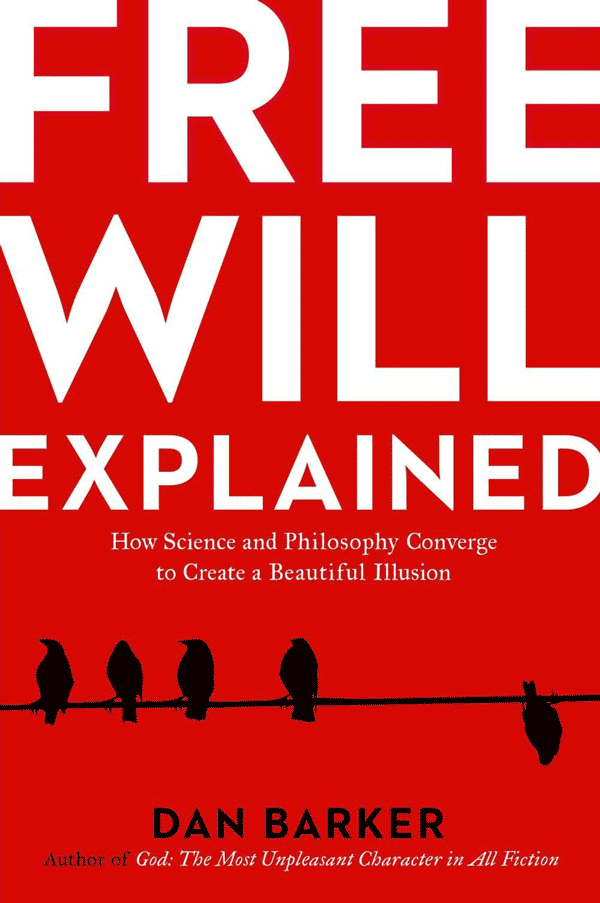Foreword to Free Will Explained: How Science and Philosophy Converged to Produce a Beautiful Illusion, by Dan Barker (Sterling. 2018. ISBN 9781454927358).

In 1985, the physiologist Benjamin Libet conducted a series of experiments that involved taking EEG readings of subjects’ brains engaged in a task that required them to press a button at random intervals whenever they felt like it during the session. Results: several seconds before the “decision” was consciously made by the subject, the brain’s motor cortex was activated.1 The neuroscientist John-Dylan Haynes employed fMRI brain scans in a 2011 study in which subjects inside the scanner were instructed to press one of two buttons whenever they wanted while observing a series of random letters. The subjects were told to verbally report which letter was on the screen when they “decided” to press the button. Results: the time between brain activation and conscious awareness of a “choice” was several seconds, and in some cases a full seven seconds.2
In these studies, and others, scientists measuring subjects’ brains know which decision they would make before the subjects themselves know it! That is spooky, and if these results don’t bother you then you’re not thinking hard enough about them. What they imply is that we are not free to choose in the way we think we are. We feel free, but that’s just what our conscious self believes because it doesn’t know about the inputs feeding into it from below that have already made the choice. As the neuroscientist Sam Harris articulated it in his widely-read book Free Will, “Our wills are simply not of our own making. Thoughts and intentions emerge from background causes of which we are unaware and over which we exert no conscious control. We do not have the freedom we think we have.”3 (continue reading…)
Comments Off on Finding Freedom in a Determined Universe
Reasons to Believe is a thought-provoking documentary by filmmaker Ben Fama Jr., that explores the psychology and science of belief and why we believe, sometimes falsely, in things that may not match up with reality. Facilitated by leaders in the fields of science, philosophy, neuroscience, moral reasoning, psychology, perception, memory formation, and indoctrination, these experts answer a variety of thought provoking questions and provide tangible structure to the definition and creation of belief in the human brain. Fama asks the question: Why do we believe?
Starring: Michael Shermer, Peter Boghossian, Jennifer Whitson, Caleb Lack and Chad Woodruff. Official website
Comments Off on Michael Shermer in Reasons to Believe
Can a brain’s connectome be preserved forever?
The soul is the pattern of information that represents you—your thoughts, memories and personality—your self. There is no scientific evidence that something like soul stuff exists beyond the brain’s own hardwiring, so I was curious to visit the laboratories of 21st Century Medicine in Fontana, Calif., to see for myself an attempt to preserve a brain’s connectome—the comprehensive diagram of all neural synaptic connections.
This medical research company specializes in the cryopreservation of human organs and tissues using cryoprotectants (antifreeze). In 2009, for example, the facility’s chief research scientist Gregory M. Fahy published a paper in the peer-reviewed journal Organogenesis, documenting how his team successfully transplanted a rewarmed rabbit kidney after it had been cryoprotected and frozen to -135 degrees Celsius through the process of vitrification, “in which the liquids in a living system are converted into the glassy state at low temperatures.”
Can brains be so preserved? Fahy and his colleague Robert L. McIntyre are now developing techniques that they hope will win the Brain Preservation Technology Prize, the brainchild of neuroscientist Kenneth Hayworth (I’m on their advisory board as the advocatus diaboli). As I write this, the prize is currently valued at more than $106,000; the first 25 percent of the award will be for the complete preservation of the synaptic structure of a whole mouse brain, and the other 75 percent will go to the first team “to successfully preserve a whole large animal brain in a manner that could also be adopted for humans in a hospital or hospice setting immediately upon clinical death.” (continue reading…)
read or write comments (16)
When neuroscience meets criminology
IN HIS BEST-SELLING ESSAY entitled “Guns,” Stephen King contrasts a mass killer’s school yearbook picture, “in which the guy pretty much looks like anybody,” and the police mug shot of someone who looks “like your worst nightmare.”
Do criminals look different from noncriminals? Are there patterns that science can discover to enable society to identify potential felons before they break the law or to rehabilitate them after? University of Pennsylvania criminologist and psychiatrist Adrian Raine attempts to answer these and related questions his book The Anatomy of Violence: The Biological Roots of Crime (Pantheon, 2013). Raine details how evolutionary psychology and neuroscience are converging in this effort. For example, he contrasts two cases that show new ways to look at the origins of wrongdoing. First is the example of “Mr. Oft,” a perfectly normal man turned into a pedophile by a massive tumor at the base of his orbitofrontal cortex; when it was resected, he returned to normalcy. Second, we learn of a murderer-rapist named Donta Page, whose childhood was so horrifically bad—he was impoverished, malnourished, fatherless, abused, raped and beaten on the head to the point of being hospitalized several times—that his brain scan “showed clear evidence of reduced functioning in the medial and orbital regions of the prefrontal cortex.” (continue reading…)
read or write comments (9)




